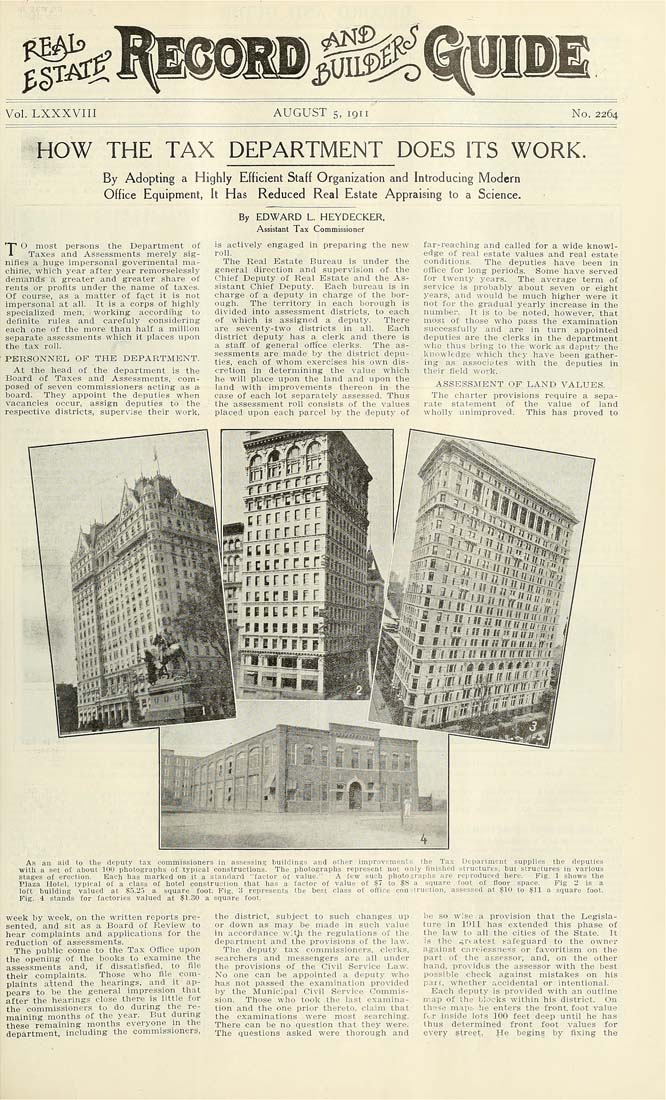Columbia University Libraries Digital Collections: The Real Estate Record
Use your browser's Print function to print these pages.
Real estate record and builders' guide: v. 88, no. 2264: August 5, 1911

Text version:
Please note: this text may be incomplete. For more information about this OCR, view About OCR text.
m^, VoL LXXXVIII AUGUST 5, iQii No. 2264 HOW THE TAX DEPARTMENT DOES ITS WORK. By Adopting a Highly Efficient Staff Organization and Introducing Modern Office Equipment, It Has Reduced Real Estate Appraising to a Science. To most persons the Department of Taxes and Assessments merely sig¬ nifies a huge impersonal govermental ma¬ chine, which year after year remorselessly demands a greater and greater share of rents or profits under the name of taxes. Of course, as a matter of ti^ct it is not impersonal at all. It is a corps of highly specialized men. working accordiiig to definite rules and carefuly considering each one of the more than half a million separate assessments which it places upon the tax roll. PERSONNEL OF THE DEPARTMENT. At the head of the department is the Board of Taxes and Assessments, com¬ posed of seven commissioners acting as a- hoard. They appoint the deputies when vacancies occur, assign deputies to the respective districts, supervise their worlt, By EDWARD L. HEYDECKER, Assistant Tax Commissioner is actively engaged in preparing the new roll. The Real Estate Bureau is under the general direction and supervision of the Chief Deputy of Real Estate and the As- si.stant Chief Deputy. Each bureau is in charge of a deputy in charge of the bor- ougli. The territory in each borough is divided into assessment districts, to each of which is assigned a deputy. There are seventy-two districts in all. Each district deputy has a clerk and there is a staff of general ofiice clerks. The as¬ sessments are made by the district depu¬ ties, each of whom exercises his own dis¬ cretion in determining the value which he will place upon the land and upon the land with improvements thereon in the case of each lot separately assessed. Thus the assessment roll consists of the values placed upon each parcel hy the deputy of far-reaching and called for a wide knowl¬ edge of real estate values and real estate conditions. The deputies have heen in ofiice for long periods. Some have served for twenty years. The average term of service is probably about seven or eight years, and would be much higher were it not for the gradual yearly increase in tlie number. Tt is to be noted, however, that most of those who pass the examination successfully and are in turn appointed deputies are the clerks in the department wlio thus bring to the work as dsputy the knowledge which tliey have been gather¬ ing as associates with the deputies in their field work. ASSESSMENT OF LAND VALUES. The charter provisions require a sepa¬ rate statement of the value of land wholly unimproved. This has proved to As an aid to the deputy tax commissioners in assessing buildings and other improvements the Tax DeparLhient supplies the deputies with a set of atiout KIO photographs o£ typical constructions. Tlie photographs represent not only finished structures, hut structures in various stages o£ erection. Baeli has marked on it a standard "factor of value." A few such photographs are reproduced here. Fig. 1 shows the Plaza Hotel, typical of a class of hotel construction that lias a lactor of value of JfT to ?S a square foot ol floor space. Fig 2 is a loCt huilding valued at ^5.'2a a square fool. Fig. 3 represents tbo best class of oflice conslruclion, assessed at IflO fo IfU a square fool. Fig. 4 stands for factories valued at .^1.30 a square foot. week by week, on the written reports pre¬ sented, and sit as a Board of Review to hear complaints and applications for the reduction of assessments. The public come to the Tax Office upon the opening of the books to examine the assessments and, if dissatisfied, to file their complaints. Those who file com¬ plaints attend the hearings, and it ap¬ pears to be the general impression that after the hearings close there is little for the commissioners to do during the re¬ maining months of the year. But during these remaining months everyone m the department, including the commissioners, the district, subject to such changes up or down as may be made in such value in accordance wltji the regulations of the department and the provisions of the law. The deiJuty tax comniissioners, clerks, searchers and messengers arc all under the provisions of the Civil Service Law. No one can be appointed a deputy who has not passed the examination provided by the Municipal Civil Service Commis¬ sion. Those who took the last examina¬ tion and the one prior thereto, claim that the examinations were most searching. There can be no question that they were. The questions asked were thorough and be so wise a provision that the Legisla¬ ture in 1911 has extended this phase of the law to all the cities of the State. It is tho .;rtatest safeguard to the owner against carelessness or favoritism on the part of the assesso)', and, on the other hand, provides the assessor with the best possible check against mistakes on his part, whether accidental or intentional. Each deputy is provided with an outline map of the blocks within his district. On lh'^5,3 maps he enters the front foot value ft.r inside lots IOO feet deep until he has thus determined front foot values for every street, He begins by fixing the